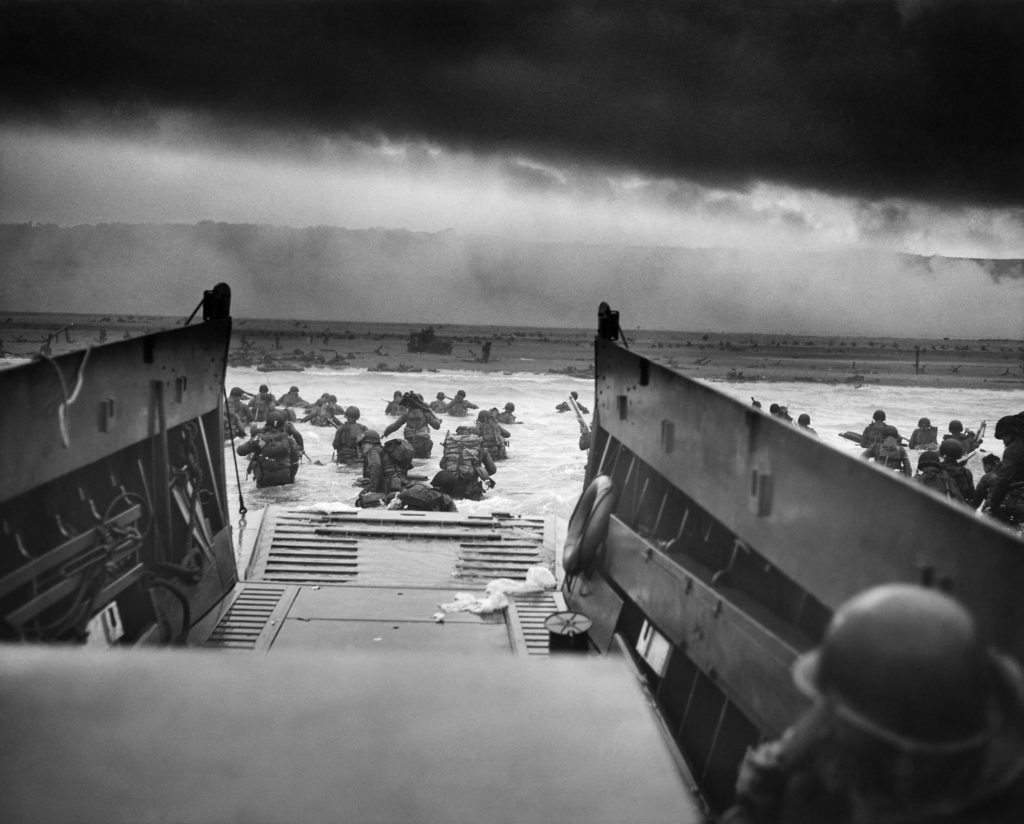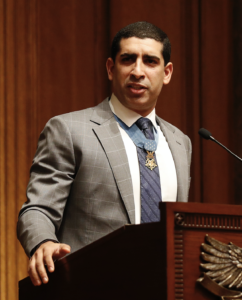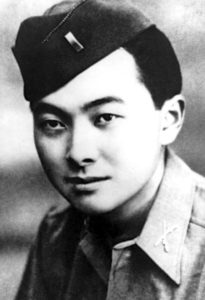The ‘beginning of the end of World War II’ came on June 6, 1944. Though World War II contained many “D-Days” the one most fixed in the popular imagination is the D-Day that saw the Allies invade France at Normandy. Planned for over a year before it started, more than 130,000 Allied troops stormed into Normandy in early June by sea and by air in the largest amphibious landing in military history.
Over the evening of June 5 and into the morning of June 6, planes carried 13,000 paratroopers, gliders carried 4,000 glider infantry, and landing craft carried 57,000 infantry to storm into Normandy and breach Hitler’s Atlantic Wall. On the eve of battle Dwight Eisenhower has a message for the men about to invade France:
Soldiers, Sailors and Airmen of the Allied Expeditionary Force: You are about to embark upon the Great Crusade, toward which we have striven these many months. The eyes of the world are upon you. The hope and prayers of liberty-loving people everywhere march with you. Your task will not be an easy one. Your enemy is well trained, well equipped and battle-hardened. He will fight savagely.
But this is the year 1944! The tide has turned! The free men of the world are marching together to victory! I have full confidence in your courage, devotion to duty and skill in battle. We will accept nothing less than full victory! Good luck! And let us all beseech the blessing of Almighty God upon this great and noble undertaking.
—Gen. Dwight D. Eisenhower, Supreme Allied Commander, 6 June 1944.
It took five days of fighting before the Allies secured the landing beaches, codenamed Omaha, Utah, Gold, Juno, and Sword. Having a safe landing zone on June 11, 1944, meant that the Allies could install two massive temporary harbors, though one was soon damaged beyond repair by weather. These harbors had taken six months to construct in England prior to their installation in France. Millions of men, tons of supplies, and hundreds of thousands of vehicles would be unloaded on the beaches of Normandy. Having available and protected beachheads allowed Allied forces to then turn their attention to liberating the rest of Normandy.
A large component of the Allied plan was the connection of all five beachheads into one continuous front. As part of this effort, the 101st Airborne Division and the 2nd Armored Division had captured and secured the town of Carentan in order to link up Omaha and Utah beaches. One of the first major Allied objectives was capturing the port town of Cherbourg which was at the end of the Cotentin Peninsula. Fighting for the town was long and bloody, taking until June 30 and costing 2,800 Allied lives and more than 10,000 wounded.
Liberating Normandy also required capturing the city of Caen, a six-week-long battle that started on June 6 and ended on July 19. Caen was an important Allied objective as it was a road hub and strategically straddled a river and a canal. German forces were entrenched in the suburbs around the town and within the town itself as they knew its strategic importance. Capturing Caen from the Germans cost the Allies 30,000 casualties.
Not content to leave the Allies with the initiative, German forces counter-attacked on August 8 leading to the Battle of the Falaise Pocket. The advisability of the counterattack, given the state of German forces in Normandy and the attempted assassination of Hitler on July 20 is questionable. This battle was a decisive engagement in the liberation of Normandy from German control and destroyed the hope of enemy resistance in the region. By the end of August 1944, the Allies were victorious in Normandy. All told the liberation of Normandy cost the Allies over 200,000 casualties, of which more than 120,000 were American.
When the invasion was launched its success was far from certain, though we now know it marked the beginning of the end of Nazi Germany. Of the hundreds of thousands of men who fought to liberate Normandy, sixteen soldiers were awarded the Medal of Honor for their actions during the campaign that began on D-Day – nine of those were awarded posthumously. Learn more about their heroism.
Securing the Beachheads (June 6 – June 11)
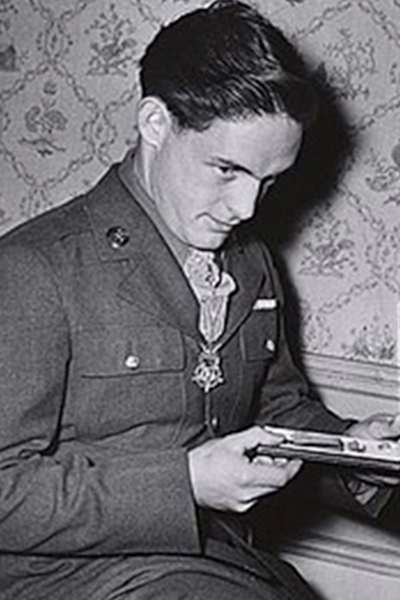
PVT Carlton W. Barrett
Landed at Omaha Beach
Medal of Honor Action: June 6, 1944
Barrett was fighting near St. Laurent-sur-Mer, France on the morning of D-Day he waded ashore through neck-deep water. Barrett, working with fierce determination, saved many lives by carrying casualties to an evacuation boat lying offshore. Barrett not only did his assigned mission as a guide, he also carried dispatches while under enemy fire, gave aid to the wounded, and served as a leader for other men.
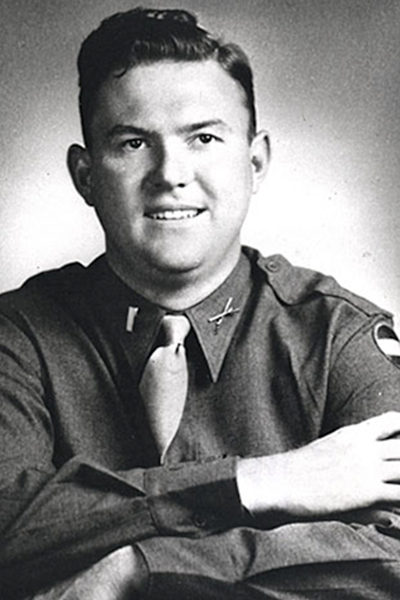
1LT Jimmie W. Monteith Jr.
Landed at Omaha Beach
Medal of Honor Action: June 6, 1944
Monteith landed with the initial assault waves on the coast and he continually moved up and down the beach organizing men for further assault. Monteith led two tanks, on foot, through a minefield, and into firing positions and directed them in the destruction of several enemy positions. He then rejoined his company and under his leadership, his men captured an advantageous position on a cleared hill. Monteith was killed while overseeing the defense of his newly won position after being surrounded by enemy forces.
Learn more about Jimmie Monteith
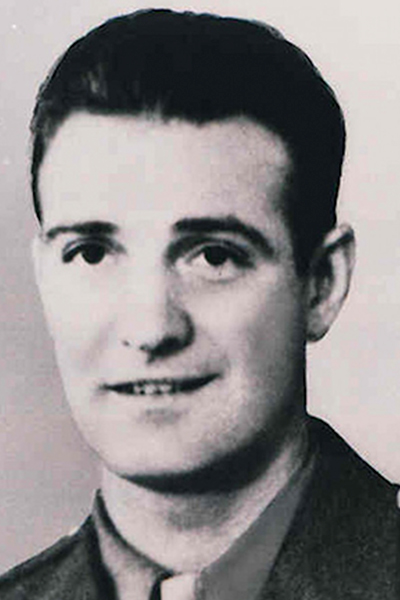
T/5 John J. Pinder Jr.
Landed at Omaha Beach
Medal of Honor Action: June 6, 1944
On June 6, 1944, near Colleville-sur-Mer, France Pinder landed on the coast 100 yards offshore under enemy machine gun and artillery fire which caused severe casualties among the boatload. Carrying a vitally important radio, he struggled towards shore in waist-deep water. Only a few yards from his craft he was hit by enemy fire and was gravely wounded. Despite his wound, he made it to the shore and delivered the radio. Pinder was wounded again while trying to establish radio communications on the beach. Though he was successful in his mission, he was mortally wounded after being struck by enemy fire a third time.
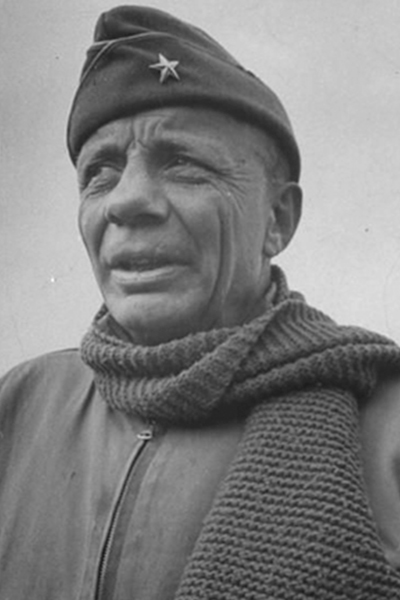
BG Theodore Roosevelt Jr.
Landed at Utah Beach
Medal of Honor Action: June 6, 1944
Roosevelt’s written request, after two previous requests had been denied, was approved and he landed with the first wave of the forces assaulting the enemy-held beaches. He repeatedly led groups from the beach, over the seawall and established them inland. The beach was under constant fire, but Roosevelt moved around them freely, rallying and directing them against the enemy. His leadership was integral to the establishment of the beachhead in France. When he landed on Utah Beach on June 6, 1944, Roosevelt, at the age of 56, became the oldest person to land on D-Day. Five weeks after coming ashore, Theodore Roosevelt Jr., died of a heart attack.
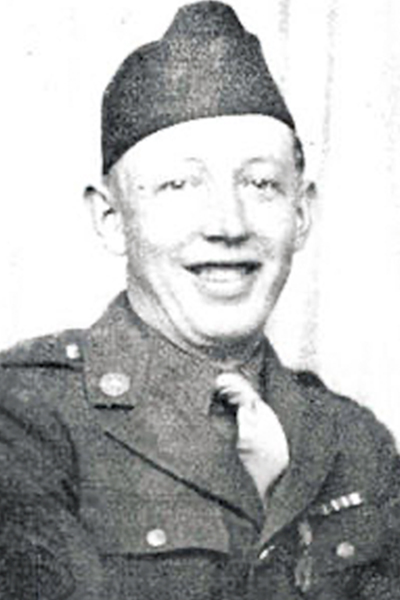
T/SGT Frank D. Peregory
Landed at Omaha Beach
Medal of Honor Action: June 8, 1944
On 8 June 1944 Peregory, on his own initiative, advanced up the hill under fire, and worked his way to the crest where he discovered an entrenchment from which machine gun fire was holding up his unit’s advance. He attacked a squad of enemy riflemen with hand grenades and bayonet, killing 8 and forcing 3 to surrender. His offensive did not stop there. Peregory single-handedly forced the surrender of 32 more riflemen, captured the machine gunners, and opened the way for his battalion to advance.
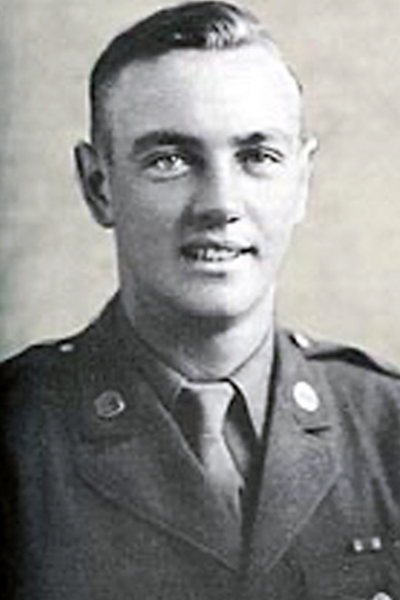
PFC Charles N. DeGlopper
Flew into France as part of the 325th Glider Infantry Regiment
Medal of Honor Action: June 9, 1944
On 9 June 1944 DeGlopper was advancing with the forward platoon to secure a bridgehead across the Merderet River at La Fiere, France. Shortly after penetrating the outer line of defense, the platoon was surrounded by German forces. DeGlopper volunteered to support his comrades by fire from his automatic rifle while they attempted a withdrawal. He leveled his heavy weapon against the enemy fire upon them, killing many until he was cut down.
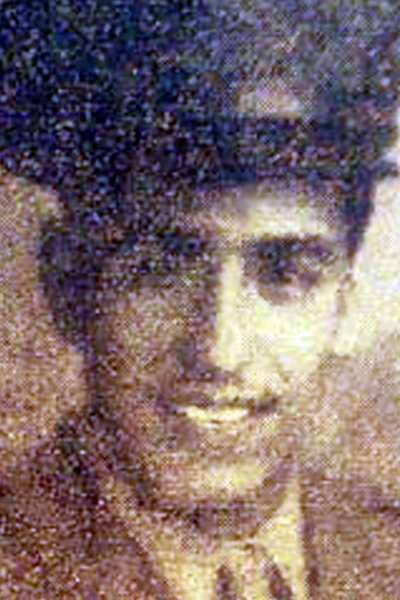
PVT Joe Gandara
Parachuted into France as part of the 507th Parachute Infantry Regiment
Medal of Honor Action: June 9, 1944
Gandara distinguished himself during combat operations against an armed enemy in Amfreville, France on June 9, 1944. Gandara’s detachment was pinned under heavy German fire for four hours. Gandara voluntarily advanced alone and destroyed three hostile machine guns before he was fatally wounded.
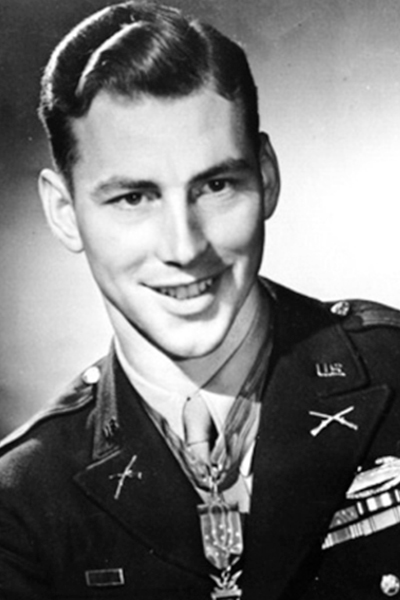
SSG Walter D. Ehlers
Landed at Omaha Beach
Medal of Honor Action: June 9 – 10, 1944
Ehlers, always acting as the spearhead of the attack, repeatedly led his men against heavily defended enemy strong points. Without waiting for an order, S/Sgt. Ehlers, far ahead of his men, led his squad against a strongly defended enemy strong point, personally killing 4 of an enemy patrol. Turning his attention to 2 mortars protected by the crossfire of 2 machine guns, Ehlers led his men through this hail of bullets to kill or put to flight the enemy of the mortar section, killing 3 men himself. He then knocked out another machine gun single-handed. The next day, Ehlers covered the withdrawal of his platoon as it weathered intense enemy fire, during which he was wounded. After having his wound treated, he refused to be evacuated and returned to lead his squad.
SSG Arthur F. Defranzo
Landed at Omaha Beach
Medal of Honor Action: June 10, 1944
On June 10 DeFranzo courageously moved out in the open to the aid of a wounded scout and was himself wounded but brought the man to safety. Refusing aid, DeFranzo reentered the open field, led the advance upon the enemy, and silenced 2 machine guns. While advancing he was again wounded, but continued on until he was within 100 yards of the enemy position and even as he fell, he kept firing his rifle and waving his men forward. At the cost of his own life, he made possible his company’s advance with a minimum of casualties.
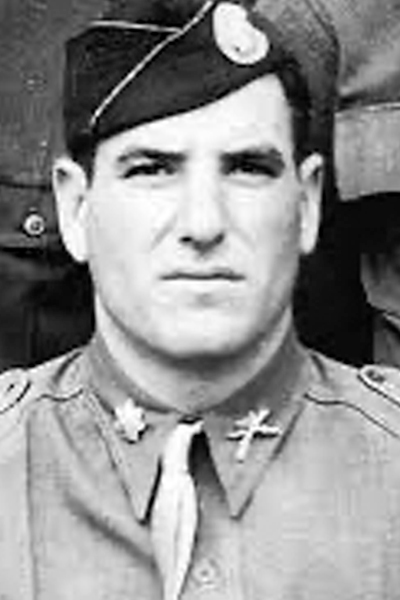
LTC Robert G. Cole
Parachuted into France as part of the 502nd Parachute Infantry Regiment
Medal of Honor Action: June 11, 1944Cole, on June 11, was personally leading his battalion in forcing the last 4 bridges on the road to Carentan. Suddenly, enemy machine guns, mortars, and artillery fire assaulted them. After enduring the fire for an hour, Cole ordered a bayonet charge upon the fortified enemy positions. He rose to his feet in front of his battalion and, with drawn pistol, shouted to his men to follow him in the assault. His attack men resulted in the complete establishment of the bridgehead across the Douve River.
Liberating Normandy (June 11 – August 21)
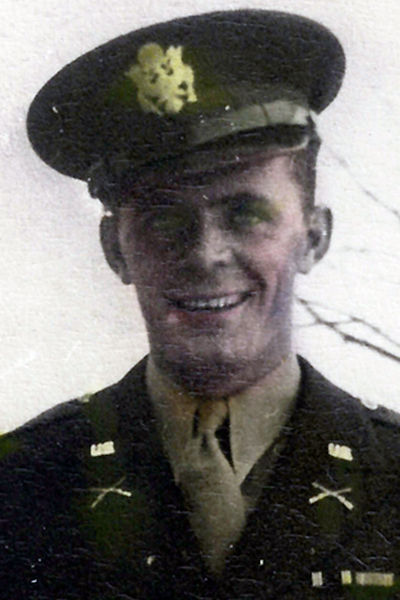
2LT John E. Butts
Landed via Utah Beach
Medal of Honor Action: June 14, 16, and 23, 1944
Although Butts was painfully wounded on the 14th near Orglandes and again on the 16th while spearheading an attack to establish a bridgehead across the Douve River, he refused medical aid and remained with his platoon. A week later, near Flottemanville Hague, he led an assault on an important and stubbornly defended hill studded with tanks, antitank guns, pillboxes, and machine-gun emplacements, and protected by concentrated artillery and mortar fire. The strong point was taken with his leadership and at the cost of his own life.
CPL John D. Kelly
Landed via Omaha Beach
Medal of Honor Action: June 25, 1944
On June 25, 1944, in the vicinity of Fort du Roule, Cherbourg, France, Kelly’s unit was pinned down by heavy machine gun fire coming from a strongpoint on the slope leading up to the fort. Kelly volunteered to attempt to neutralize the strongpoint. Armed with pole charges and grenades, and in the face of enemy machine gun fire, Kelly destroyed the strongpoint.
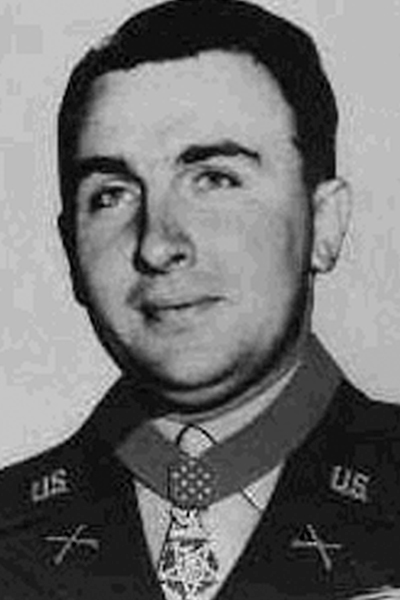
1LT Carlos C. Ogden
Landed via Utah Beach
Medal of Honor Action: June 25, 1944
On the morning of June 25, 1944, near Fort du Roule, guarding the approaches to Cherbourg, Ogden’s company was pinned down by fire from a German 88-mm. gun and 2 machine guns. Arming himself with an M-1 rifle, a grenade launcher, and a number of rifle and hand grenades, he left his company in position and advanced alone. Despite being wounded in the head, Ogden succeeded in stopping the 88mm. gun and knocked out the 2 machine guns.
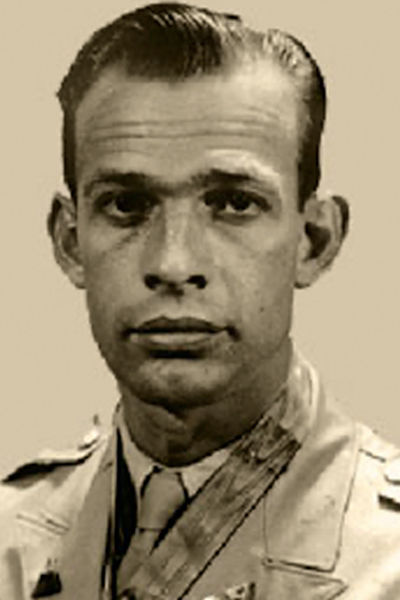
SGT Hulon B. Whittington
Landed via Omaha Beach
Medal of Honor Action: July 29, 1944
On the night of July 29, 1944, near Grimesnil, France, during an enemy armored attack. Whittington assumed command of his platoon when the platoon leader and platoon sergeant became missing in action. When the advancing enemy attempted to penetrate a roadblock, Whittington mounted a tank and directed it into position to fire pointblank at the leading Mark V German tank. The destruction of this vehicle blocked all movement of the remaining enemy column consisting of over 100 vehicles of a Panzer unit. The blocked vehicles were then destroyed and large numbers of the enemy were killed by a bayonet charged Whittington led.
SGT John D. Hawk
Medal of Honor Action: August 20, 1944
Hawk manned a light machine gun on 20 August 1944, near Chambois, France, a key point in the encirclement which created the Falaise Pocket. His fire forced the infantry to withdraw, but an artillery shell knocked out his gun and wounded him in the right thigh. Hawk reorganized 2 machine gun squads and, in the face of intense enemy fire, directed the assembly of 1 workable weapon from 2 damaged guns. In order to aid Allied tank destroyers, Hawk, despite his wound, climbed to an exposed position on a knoll where he became a human aiming stake for the destroyers. He repeatedly returned from the knoll to the tank destroyers so that he could direct their fire against German tanks threatening the line. His actions stopped 2 German attempts at breakout and led to the capture of 500 enemy soldiers.
Invasion of Normandy Related Medal of Honor
Matt Urban
Landed via Utah Beach
Medal of Honor Action: June 14 – September 3, 1944

JK – John D. Kelly
CO – Carlos C. Ogden
JG – Joe Gandara
JB – John E. Butts
CD – Charles N. DeGlopper
RC – Robert G. Cole
TR – Theodore Roosevelt, Jr.
FP – Franks D. Peregory
JP – John J. Pinder, Jr.
CB – Carlton W. Barrett
JM – Jimmie W. Monteith Jr.
WE – Walter D. Ehlers
AD – Arthur F. Defranzo
